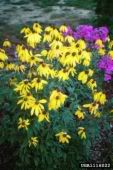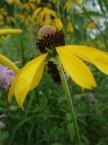

Scientific Name
Ratibida pinnata
Uses of Pinnate Prairie Coneflower: Landscaping, Medicinal, Culinary, etc...
Ethnobotanic: American Indians used the flower cones and leaves to make a tea, and the root was used as a cure for toothache (Runkel and Roosa 1989).
Landscaping and Wildlife: Yellow coneflower produces an attractive and distinct flower that is easily grown in gardens. The flowers attract butterflies throughout the summer, and its seeds are sought by birds in the late fall.
Forage: When young, it provides good grazing for livestock (Runkal and Roosa 1989). However, the stems become woody with age, and less palatable.
Required Growing Conditions
Yellow coneflower is a member of the daisy family, Asteraceae, and is a summer perennial. It grows up right and may be a meter or more in height. The slender, grooved stems have fine, upward pointing hairs, and may branch with a flower on top of each stem. The flowers may have between 5 to 10 petals that droop down toward the stem with a distinct “cone” in the center.
Distribution: This species is widely distributed across the United States. It can be found up and down the east coast from Vermont to Florida and westward to Kansas, Oklahoma, and Nebraska. It is most commonly associated with the prairie regions of the central United States, and is often seen along roadsides.
Cultivation and Care
Stands of this species can be readily established from seed. Plantings can be made in either the spring or fall. Spring plantings may require the seed to be stored slightly above freezing for at least 30 days to ensure good germination. The seed requires a clean, firm seed bed, and may be drilled or broadcast. Stands have been established using 12-24 inch row spacing at a seeding rate of 20-40 seeds per foot, and by broadcasting 5 pounds of seed per acre. Four ounces per acre is recommended when mixed with other species.
General Upkeep and Control
Yellow coneflower is not inhibited by competition, and does well when used in conjunction with other species. It has an open structure and should be planted in relatively dense stands to inhibit weed growth if a monoculture is desired.
Pests and Potential Problems Birds will feed heavily on the seed heads of this flower in the fall of the year. This is advantageous for the wildlife watcher, but maybe a potential problem for those growing this species for seed production.
Cultivars, Improved, and Selected Materials (and area of origin) ‘Sunglow’ – (Kansas) Sunglow was released in 1978, and has shown to have excellent vigor. This cultivar is especially adapted to the central United States. Its range includes portions of South Dakota, Minnesota, Nebraska, Iowa, Missouri, Illinois, Kansas, Oklahoma, and Arkansas. This plant material is readily available from commercial sources.





0 comments: